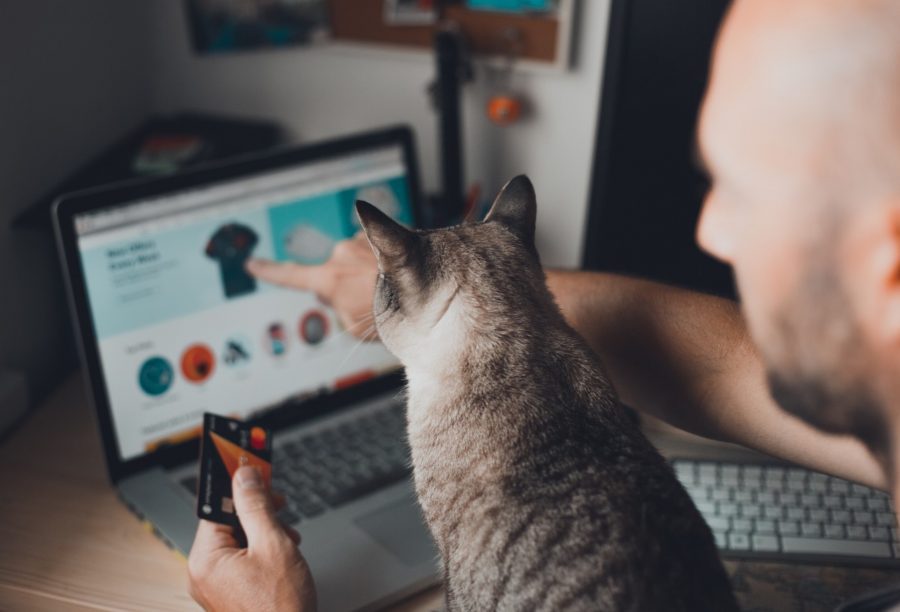
Omnichannel marketing strategies include an approach that considers the different places a customer might interact with your brand. The process allows for the same experience no matter the location of various client touchpoints. So, if a user visits your website and then bounces over to social media, their needs are met at each point, and the information also remains consistent.
In a study on the impact of omnichannel strategies, researchers found these campaigns received an 18.96% engagement rate, while single-channel efforts only hit 5.4%. Customers feel more involved when they experience a brand in multiple mediums.
Imagine your customer buys a new sweater from your e-commerce store. They don’t like the fit and want to exchange it for a size larger. Rather than going through the process of mailing the item back and waiting for a replacement, they can simply take it to your store for an exchange. Or, perhaps they first see the sweater in a Facebook ad, but they have a few questions, so they pop over to your website and engage a live chat agent.
You’ve probably also heard that omnichannel marketing costs could add up.
Fortunately, budget-friendly ways of improving your omnichannel experience exist:
1. Align Content
Start by looking at the content at each touchpoint. Does it meet the customers’ needs at that part of their journey? If you have a video explaining how to use the product, but the user is still in the information-gathering stage, it falls flat. You don’t need to throw out things that don’t fit — but move them to an area where they do.
Think about the purpose of omnichannel marketing — to better meet clients’ needs at every level of their experience. Your content is a big part of that equation. Start by refining what you offer on each channel and each location within each channel, and you’ll automatically become more customer-centered.
2. Check Advertising Effectiveness

While your image and offers should be consistent, think about the places where you advertise. An offer listed on Facebook might be a bit different than one hosted on LinkedIn and aimed at business owners. A flag placed in front of your store has a more distinct immediacy than an ad in a local newspaper. The underlying goal is to spread your message to customers and draw traffic to your business.
A physical banner accomplishes that, but so do many other marketing methods. Think about which technique works best with which buyers at each touchpoint.
3. Invest In IP Targeting
One cost-effective way of reaching a specific audience is through Internet Protocol (IP) targeting. Highly personal ads should be part of your omnichannel approach if they aren’t already. Those in your target audience have certain behaviors or interests.
By tracking specific devices in particular locations — and following the user’s IP — you can deliver marketing messages directly to a phone or computer in the person’s home or place of business. Direct marketing is a powerful form of advertising that allows you to reach your audience with pinpoint accuracy.
4. Offer A Single Customer Experience (CX) Model

No matter where a customer encounters your brand, they should have a similar experience. Start with a solid customer-experience policy and train all your employees in the same methods. If a shopper contacts your company via telephone, they should get the same answer they’d receive if they came into your store. Robust training and a set of firm policies ensure everything remains consistent.
At the same time, though, train your employees to put the customer first. If someone isn’t happy with the procedure, are your employees empowered to make exceptions when it makes sense? Perhaps someone wants to return an item a few hours after the return window. Do you want to be such a stickler for the rules that you lose a customer for life because your employee won’t accept the return?
5. Integrate Your Systems
If you have separate customer relationship management (CRM) systems, it’s time to integrate them into one. If you want to offer customers an authentic omnichannel experience, they should be able to connect from one channel to the next seamlessly. The first time a lead contacts your brand, you should collect and store specific information so future sales agents can access it.
For example, Mary looks at a cute new pair of shoes on your website. She contacts the live agent to see if they fit true to size. Mary isn’t quite sure if she wants them yet or if she should wait for an upcoming sale. You now have Mary’s info and can market the shoes directly to her when they do go on sale. One way you can do this is by sending her a special offer via email.
However, if Mary calls your company and wants to order them, she shouldn’t have to share all her information again. Your agent should say, “I have your mailing address as 123 Main Street, ABC Town, USA. Is that still correct?”
Go Deeper
The goal of omnichannel marketing strategies is to go deeper than a typical marketing campaign. Use touchpoints to create a more personalized experience with each subsequent interaction. Your follow-up needs to hit at the right time in the right way. A well-connected system, a smart overall customer experience plan, and well-trained employees ensure you meet each customer’s needs at specific points in the buyer’s journey.
Guest Post Author Bio
Lexie is a digital nomad and web designer. When she’s not traveling to various parts of the country, you can find her at the local flea markets or hiking with her goldendoodle. Check out her design blog, Design Roast, and connect with her on Twitter @lexieludesigner.
Contact Matchbox Design Group Today!
If your website could use a refresh or you’re looking to drive more traffic to your site, fill out the form below and we’ll contact you to learn more about your digital needs.

